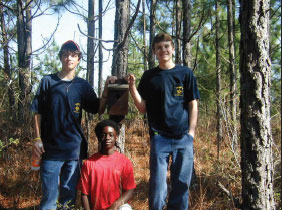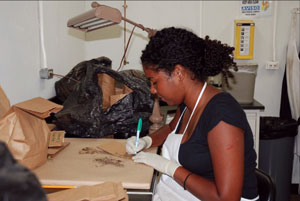Volunteers in the National Forests Program
Volunteers in the National Forests Act
The Volunteers in the National Forests (VIF) program is authorized by the Volunteers in the National Forests Act of 1972. Before passage of the act, the Forest Service did not have the authority to accept voluntary services or to reimburse individuals for associated personal expenses. The Volunteers in the National Forests Act recognized the public's interest in giving time and skills for community service. Volunteers are enrolled by the Forest Service under this act. Volunteers receive no salary or wages from the Forest Service and give their time and talents to further the agency's mission (figure 4).

Figure 4—A volunteer helps the Forest Service with wildlife viewing.
Courtesy
of Ginger Hamilton, Forest Service, Northern Region
A volunteer is not considered a Federal employee and is not subject to the provisions of laws relating to Federal employment except for the purpose of tort claims or workrelated injuries (Federal Employees Compensation Act of 1974).
USDA Nondiscrimination Statement
"The U.S. Department of Agriculture (USDA) prohibits discrimination in all its programs and activities on the basis of race, color, national origin, age, disability, and where applicable, sex, marital status, parental status, religion, sexual orientation, genetic information, political beliefs, reprisal, or because all or a part of an individual's income is derived from any public assistance program. (Not all prohibited bases apply to all programs.) Persons with disabilities who require alternative means for communication of program information (Braille, large print, audiotape, etc.) should contact USDA's TARGET Center at 202–720–2600 (voice and TDD). To file a complaint of discrimination, write to USDA, Director, Office of Civil Rights, 1400 Independence Avenue, S.W., Washington, D.C. 20250-9410 or call 800–795–3272 (voice) or 202–720–5382 (TDD). USDA is an equal opportunity provider and employer."—USDA Equal Employment Opportunity Policy Statement
Volunteer Work
Volunteers are at the very heart of the Forest Service. You may assist in any Forest Service program or activity but cannot perform law enforcement activities or fight fire. A variety of jobs are available, ranging from office work to vigorous physical labor outdoors. Some typical volunteer activities include:
- Maintaining and hosting campgrounds
- Answering phones, greeting visitors, and answering mail at Forest Service visitor centers and ranger stations
- Working with computers in Forest Service administrative offices
- Taking photographs
- Planting trees and seeding damaged areas (figure 5)
- Presenting environmental education programs
- Building and repairing fences, nest boxes (figure 6), picnic tables, and other structures
- Building barrier-free campsites, docks, and trails
- Restoring damaged streambanks and burned areas
- Building and maintaining trails (figure 7)

Figure 5—Volunteers help with plant restoration on the
Hiawatha National
Forest. Courtesy of Gary Morgan,
Forest Service, Eastern Region

Figure 6—Local volunteers help with a nest box, a wildlife opening,
and
structure maintenance project for the wildlife program.
Courtesy of Art Henderson,
Talladega National Forest

Figure 7—Volunteers work on the Forks Area Trail System,
one of the premier
mountain bike trails in the Southeast.
Courtesy of Elizabeth Meadows, Francis
Marion and Sumter National Forests
You may work part time or full time and can participate in a daylong project or serve over several months, seasons, or years. You are limited only by your willingness to serve. However, such service must benefit the Forest Service.
Volunteer Agreements
The three types of volunteer agreements are:
- FS 1800-6 for international volunteers
- FS 1800-7 for individual volunteers
- FS 1800-8 for sponsored or group voluntary service.
These agreements allow the Forest Service to accept your services and work. In essence, the agreement is the contract between you and the Forest Service. You may not begin work or travel on an assignment until the agreement is signed.
The volunteer agreement can be modified at any time with the written consent of each party. The existing agreement can be terminated, a new agreement can be developed, or a signed and dated amendment can be attached to the existing agreement.
Difference Between Individual and Sponsored Volunteer Agreements
The individual volunteer agreement is used for people who want to donate their time and talent to the Forest Service and are not associated with an organized group (figure 8).

Figure 8—A volunteer at the International Institute
of
Tropical Forestry
sorts organic litter.
Courtesy of Elizabeth
(Liza) Hernandez, Forest Service,
International Institute of Tropical Forestry
A sponsored volunteer agreement is used for people who belong to or are supervised by another institution or organization or by a unit of State or local government. Some of these groups include the Florida Trail Association, Girl or Boy Scouts (figure 9), and the Back Country Horsemen. These groups recruit, train, and host volunteers along with or in partnership with the Forest Service. These volunteers are documented as a group under the name of their sponsor organization on the sponsored volunteer agreement. In addition to the Forest Service guidelines and regulations, volunteers working under a sponsored volunteer agreement may be provided with guidance from their sponsoring organization. If you are working under a sponsored volunteer agreement, you will need to check with your host organization as well as your Forest Service volunteer coordinator to make sure you have all of the information needed to make your experience fruitful and enjoyable.

Figure 9—A local Boy Scout helps with a National Trails Day
habitat restoration
project for the NatureWatch program.
Courtesy
of
Heather Hundt, Humboldt-Toiyabe
National Forest
What Are Partnerships?
The words "partnership" and "partners" are used in a broad way to describe relationships between the people, organizations, agencies, and communities that work together and share interests. The Forest Service regularly works in partnership with other entities, including Tribes, States, Federal agencies, nonprofits, businesses, and communities.
The word "partnership" also has a precise meaning. Federal policy defines partnerships as "arrangements that are voluntary, mutually beneficial, and entered into for the purpose of mutually agreed upon objectives." In this definition, "mutual benefit" specifically means that each partner shares in the benefits the project provides.
(continued)

